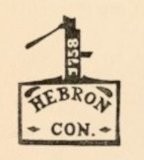
The Hebron Historical Society
Hebron, Connecticut
Enjoy Hebron - It's Here To Stay ™

American women were formally granted the right to vote August 18, 1920 as a result of the 19th amendment to the United States Constitution, which proclaimed: “The right of citizens in the United States to vote shall not be denied or abridged by the United States or by any State on account of sex.” The 36 states needed for ratification had done so by March 22, 1920; all states ratified the amendment except traditional southern states, Vermont, and [believe it or not] Connecticut.
Women’s suffrage was a heated battle nationwide in the first two decades of the 20th century. Born in New York in 1848, the suffragette movement quickly moved west. Women filed lawsuits, chained themselves to fences, were arrested, and spent time in jail; a few died. History proves this was an important issue to Hebron women, although none engaged in such dramatic activities.
On September 26, 1911, Hebron Town Registrars John A. Hewitt and Carlton B. Jones certified eight women registered to vote: Mrs. Lottie Dingwell, Mrs. Anne C. Gilbert, Mrs. Inez H. Gillette, Miss Caroline E. Kellogg, Mrs. Annie S. Lord, Mrs. Grace M. Lord, Miss Susan B. Pendleton, and Mrs. Ella M. Smith. There were 202 registered men.
These eight women were on a separate list labeled “The Names of Those Women of the Town of Hebron, CT Entitled to Vote….For Town School Committee.” Since the 19th amendment hadn’t yet passed, women were only allowed to vote on this limited issue, but at least they were allowed to formally vote on an issue they considered important!
But only 5 of these women actually voted on October 2, 1911: Dingwell, Gilbert, Kellogg, Grace Lord, and Pendleton. That’s not a strong suffragette statement.
In the October 7, 1912 vote for Town School Committee, the same eight women were still listed by the Registrars, but this time, only three voted: Kellogg, Grace Lord, and Pendleton. By 1913, one more woman had registered to vote, Miss Daisy White. In the October 6 elections for Town School Committee, only three women voted. As it turned out, all were unmarried: Kellogg, Pendleton, and White.
Caroline Kellogg became the best-remembered directors of the Douglas Library; her home is remembered for its significant role in the founding of the Missionary Society. The town, without doubt, is hugely indebted to Susie Pendleton, who used her writing skills and newspaper connections to document Hebron’s history in the media. Daisy White was one of Hebron’s most beloved teachers. She dedicated her life to her students; after retiring, she cared for the White elders until their passing. All three women are buried with their parents here in town.
Speculation regarding the importance of the suffragette issue in Hebron persists because we have little written or oral documentation. Only 22 additional women registered to vote between 1913 and 1919, almost exclusively occurring in two significant bursts: September 1916, and September 1919.
But if these records make you think Hebron women didn’t care about suffrage, think again!
On Sept. 14, 1920, the Connecticut General Assembly finally approved the 19th Amendment even though it had already been signed into law by Woodrow Wilson. On Saturday, September 18, the one-month anniversary following Congress’ ratification of the 19th amendment, an unprecedented 98 residents appeared at Town Hall to register to vote. Of these, 81 were women, and the 17 men who also registered were all related to the women. Given the conservative era, it was an obvious show of support by the men for their wives and daughters.
The women of all the major families – Buell, Ellis, Foote, Hutchinson, Hills, Hilding, Tennant, Horton, Jones, Lord, Porter, Rathbun, Smith, White, and Wright – appeared in the few available cars, and by carriage, wagon, walking and horseback. They ranged in age from 22 (Ethel L. Porter and Frances Barrasso) to 78 (Clara Hammer.) There can be no doubt that September 18, 1920 was a carefully planned event by Hebron women. A second wave of 31 Hebron women registered a few weeks later on Saturday, October 9. As a result, the Hebron voter roll increased by 33% in a matter of weeks.
Prior to September 18, all women were registered with a “Miss” or “Mrs.” salutation. After September 18, only first and last names were listed. Almost all claimed “housewife” as their occupation.
A list of these early women voters is available at www.HebronHistoricalSociety.org. Thanks to Carla Pomprowicz, Ann Hughes, and Paula Verrier of the Town Clerk and Probate Court offices for providing the documents used in this research.
{phocadownload view=category|id=24}